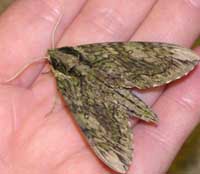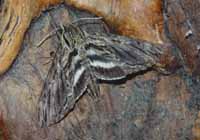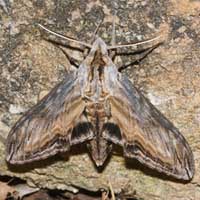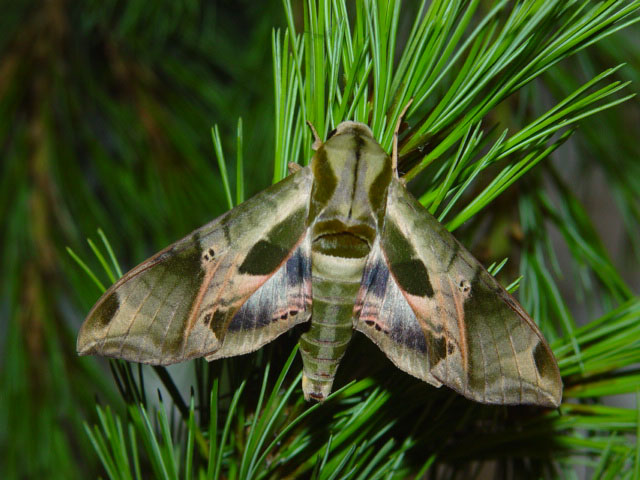Sphinginae subfamily
Sphingini tribe:
 |
This moth is a very strong flier, but would only make its way to
Montgomery County as a rare stray.
|
 |
Ceratomia amyntor,
the Elm Sphinx or Four-horned Sphinx
The upperside of the forewing is brown with dark brown and white
markings including a white costal area near the wing base, dark
streaks along the veins, and a white spot in the cell.
|
 |
The upperside of the forewing is yellowish brown with no white
markings, but there are indistinct black lines and dashes.
The larvae feed in large groups and are much more
spectacular than the moths.
Catalpa is the larval host.
|
 |
Ceratomia hageni,
Hagen's Sphinx or Osage Orange Sphinx
Larvae feed on osage orange (Maclura pomifera).
|
 |
The upperside of the forewing is pale brownish gray with wavy black
and white lines and a black-outlined white cell spot.
Note black and white collar separating thorax from abdomen. |
 |
The upperside of the forewing is dark brown with a dusting of white
scales. Some moths have patches of reddish or yellowish brown on the
wings.
|
 |
The upperside of the forewing is gray with heavy black bands. The
upperside of the hindwing is brownish gray with no markings. unlikely, generally more northerly
|
 |
The upperside is of the forewing is gray with two (sometimes one or
three) black dashes near the wing center; other markings are usually
diffuse. The upperside of the hindwing is a uniform brown-gray.
|
 |
This species has been recorded in Fairfield County.
The upperside of the forewing is gray-brown with wavy lines, black dashes, and one or
two small white spots near the center of the costa.
|
 |
The upperside of forewing is gray to grayish brown with a black line
running from the middle of the costa to the middle of the outer
margin; the line may be broken near the margin. There is a splash of
brown around the cell spot.
|
 |
Manduca quinquemaculatus, the Five-spotted Hawkmoth.
The moth abdomen usually has five but sometimes six pairs of yellow
bands. The upperside of the forewing is blurry brown and gray. If you
grow tomatoes, you have probably encountered it.
|
 |
Look for three large yellow spots
on each side of the abdomen.
|
 |
The abdomen usually has six pairs of yellow bands, broken across the
back. The sixth set of markings is quite small.
The upperside of the forewing has indistinct black, brown, and white
markings.
Larvae get very large and can strip a tomato plant. |
 | The upperside of the forewing is gray with indistinct black and
white markings. There is a series of black dashes
from the base to the tip, and a small white cell spot.
|

|
Sphinx canadensis,
Sphinx canadensis, the Canadian Sphinx, is not common, and is not
often reported anywhere.
Larval hosts are white ash (Fraxinus americana) and blueberry
(Vaccinium).
|
 |
Sphinx chersis, the Northern Ash Sphinx or Great Ash
Sphinx
The upperside of the forewing is soft dark gray to blue-gray with
a series of black dashes, one of which reaches the wing tip.
|
 |
This species is not officially recorded, but I suspect it is
present. We have
them on P.E.I., but I do not see them nearly as frequently
as I see the other Sphingidae. |
 |
Generally it
is not widely reported anywhere.
Similar to S. kalmiae
but lacks the dark bar
along the fw inner margin. unlikely |
 |
The lower forewings are predominantly brownish-yellow with a fairly wide dark bar along the inner margin.
At rest the wings hug the body, giving the moth a long slender look.
|
Smerinthini Tribe:
 |
The adults are also highly variable; sometimes wings of an individual
may be all one color or may have several colors, ranging from pale to
dark brown, and may have a white or pink tinge.
|
 |
This moth has a large, heavy body, and females can be remarkably
plump. Generally found more to the north.
|
 |
Paonias astylus, the Huckleberry Sphinx (wingspan 55-65 mm), ranges
from Maine south to Florida, west to Missouri and Mississippi.
It tends to be uncommon.
|
 |
Named for the dull grey-blue spot in the hindwing, this moth has a
wide distribution and is probably common in Hartford County.
I regularly see them on Prince Edward Island, and they are reported
as far south as Florida. |
 |
Named for the small eye-spot in the hindwing, this moth has a wide distribution
and is probably common in Hartford County.
I regularly see them on Prince Edward Island, and they are reported as far south as Florida.
|
 |
This moth is widely distributed and fairly common.
Along the East Coast, it flies from P.E.I. to Florida, with many reports from Kentucky and Michigan. |
Macroglossinae subfamily
Dilophonotini tribe:
 |
This species is not reported in Hamilton, but it might make an appearance as a rare
stray.
Males and females differ.
|
 |
This interesting day flier is not confirmed in Hamilton, but
is widely reported to the north, east and west.
They are widely distributed in the east from P.E.I. to Florida, from Alabama to Michigan. |
 |
Hemaris diffinis, the
Snowberry Clearwing or Bumblebee Moth
This moth is widespread, but it has not been officially recorded in
Hamilton. It has been confirmed in nearby counties and states.
|
Philampelini tribe:
 |
This moth is not officially reported for Hamilton, but
has been reported to north, east, south and west.
Note the differences between this moth and the Pandorus Sphinx. |
 |
This moth is not officially reported for Hamilton, however,
the moth is a strong flier and
occasionally moths and larvae turn up as very rare strays in northern
communities.
|
 |
If you have Grape or Virginia Creeper nearby, then you probably have
this species.
I often get reports of larvae from outside the reported range. |
Eumorpha pandorus, Vandalia, July 10, 2011, Stephanie Thomas
Macroglossini tribe:
 |
This day flier is widely distributed. If you have Virginia Creeper, you
probably have the Nessus Sphinx. It is reported from
Richmond.
Two bright, distinct, narrow yellow
bands are often visible on the abdomen.
|
 |
They are common in New Jersey and common
here on Prince Edward Island, and they are probably common in Montgomery Co..
You will often see this species listed as Darapsa pholus,
especially in older literature.
|
 |
Darapsa myron, the Virginia Creeper Sphinx or the Grapevine Sphinx.
If you have the
foodplants indicated in the common names, you probably have this
species nearby. |
 |
If you have hydrangea growing near a stream, then you may have the
Hydrangea Sphinx.
It has not been reported in Montgomery County,
but I suspect it is present, but probably uncommon.
|
 |
The moth's outer margin of the forewing is deeply scalloped.
The upperside is light brown with dark brown markings.
There is a small black and white spot near the tip.
|
 |
This species has
strong migrating tendancies from much further south.
There are records from New Hampshire, Maine, Michigan, Illinois, etc. |
 |
This moth is very much under reported across the United States. It
is a rapid day flier so is probably not in too many collections.
Grape is a popular larval host. I have taken it is Pottersville.
|
 |
This moth is much more common to the south. It is a strong migrant,
however. It may stray to Montgomery County.
|
|
|


